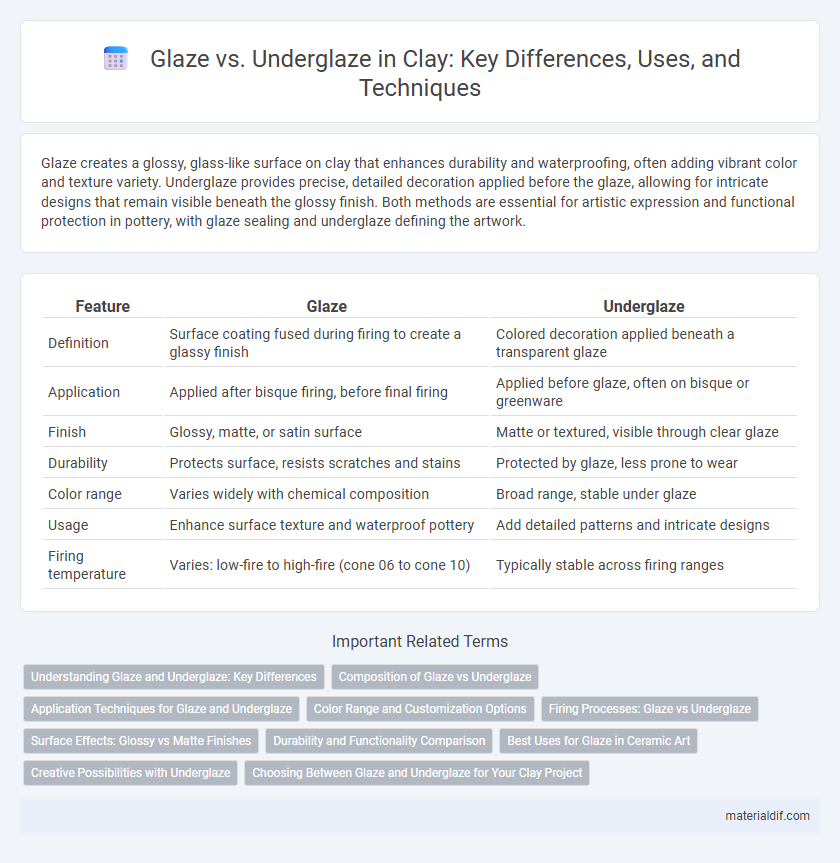Glaze creates a glossy, glass-like surface on clay that enhances durability and waterproofing, often adding vibrant color and texture variety. Underglaze provides precise, detailed decoration applied before the glaze, allowing for intricate designs that remain visible beneath the glossy finish. Both methods are essential for artistic expression and functional protection in pottery, with glaze sealing and underglaze defining the artwork.
Table of Comparison
| Feature | Glaze | Underglaze |
|---|---|---|
| Definition | Surface coating fused during firing to create a glassy finish | Colored decoration applied beneath a transparent glaze |
| Application | Applied after bisque firing, before final firing | Applied before glaze, often on bisque or greenware |
| Finish | Glossy, matte, or satin surface | Matte or textured, visible through clear glaze |
| Durability | Protects surface, resists scratches and stains | Protected by glaze, less prone to wear |
| Color range | Varies widely with chemical composition | Broad range, stable under glaze |
| Usage | Enhance surface texture and waterproof pottery | Add detailed patterns and intricate designs |
| Firing temperature | Varies: low-fire to high-fire (cone 06 to cone 10) | Typically stable across firing ranges |
Understanding Glaze and Underglaze: Key Differences
Glaze is a glassy coating applied to pottery that fuses during firing, creating a glossy, waterproof surface with vibrant, durable colors. Underglaze consists of pigmented decoration applied to clay before a clear, protective glaze is added, allowing for detailed designs with precise color control. Understanding the chemical composition and firing temperatures of glaze and underglaze is essential for achieving desired textures and finishes in ceramic art.
Composition of Glaze vs Underglaze
Glaze is composed of silica, fluxes, and alumina, forming a glassy surface layer when fired at high temperatures, while underglaze consists mainly of finely ground pigments mixed with a clay or slip base for decoration beneath a transparent glaze. The chemical composition of glaze creates a waterproof and often glossy finish, whereas underglazes are designed to retain color vibrancy through the firing process without melting or running. Understanding the differing compositions helps potters achieve desired textures, durability, and aesthetic effects on ceramic surfaces.
Application Techniques for Glaze and Underglaze
Glaze application involves brushing, dipping, or spraying a liquid glass-like coating that fuses to the clay surface during firing, creating a glossy or matte finish. Underglaze is applied with fine brushes or sponges before the glaze layer, allowing for detailed patterns and vibrant colors that remain stable after firing. Precise timing and layering are essential for underglazes to prevent smudging, while glazes require even coverage to avoid imperfections such as pinholes or crawling.
Color Range and Customization Options
Glaze offers a broad color range with vibrant, glossy finishes that can be layered for unique effects, making it ideal for bold, customizable designs. Underglaze provides more precise color control with a vast selection of matte tones that remain stable through firing, enabling detailed patterns and fine line work. The choice between glaze and underglaze depends on the desired finish and level of artistic customization in ceramic projects.
Firing Processes: Glaze vs Underglaze
Glaze undergoes a single firing process called glaze firing, where it melts to form a glassy coating, while underglaze requires two firings--first, the bisque firing to harden the clay body, and second, a glaze firing where a clear or transparent glaze is applied over the underglaze decoration. The temperature and duration of firing can influence the vibrancy and durability of the underglaze colors, as they are designed to withstand high firing temperatures without running or fading. Glaze firing typically occurs at temperatures ranging from cone 5 to cone 10 (approximately 2167degF to 2345degF), ensuring the glossy surface and protective finish are fully developed.
Surface Effects: Glossy vs Matte Finishes
Glaze produces a smooth, glass-like surface with a glossy finish that enhances color vibrancy and provides a waterproof layer, making it ideal for functional ceramics. Underglaze offers a matte or satin finish, allowing for detailed, painterly designs that retain texture and subtlety under a clear topcoat. The choice between glaze and underglaze directly impacts the tactile quality and visual depth of the ceramic piece's surface.
Durability and Functionality Comparison
Glaze provides a hard, glass-like coating that enhances durability by making pottery waterproof and resistant to scratches and stains. Underglaze, applied beneath a clear glaze, offers detailed decorative designs while maintaining the clay's structural integrity. In terms of functionality, glaze seals the surface for practical use in dishware, whereas underglaze allows for intricate patterns without compromising durability after glazing.
Best Uses for Glaze in Ceramic Art
Glaze provides a glossy, waterproof finish that enhances the durability and aesthetic appeal of ceramic art, making it ideal for functional pottery such as mugs, bowls, and plates. Its ability to fuse to the clay body at high firing temperatures allows for vibrant color variations and surface textures that highlight artistic detail. Glaze is best used when a smooth, glass-like surface is desired to protect ceramics from moisture and wear during everyday use.
Creative Possibilities with Underglaze
Underglaze offers a wider range of creative possibilities compared to traditional glaze, allowing artists to apply detailed, intricate designs and vibrant colors before firing. Its versatility enables layering and fine brushwork that remain stable through firing, preserving sharpness and clarity on both bisque and raw clay surfaces. This makes underglaze ideal for customized textures, patterns, and multi-colored effects that are difficult to achieve with conventional glaze techniques.
Choosing Between Glaze and Underglaze for Your Clay Project
Choosing between glaze and underglaze for your clay project depends on the desired finish and decorative effect. Glaze provides a glossy, glass-like coating that enhances durability and waterproofs the piece, ideal for functional ware like mugs and dishes. Underglaze offers precise, matte or satin decoration with vibrant colors that remain stable through firing, making it perfect for detailed artwork and layered designs on clay surfaces.
Glaze vs Underglaze Infographic

 materialdif.com
materialdif.com